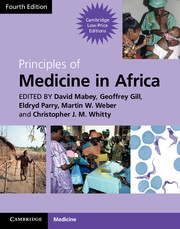Book contents
- Frontmatter
- Contents
- Contributors
- Foreword
- Section 1 Health and disease
- Section 2 Mother and child health
- Section 3 Infection: general principles
- 13 The immune response to infection
- 14 Approach to the febrile patient
- 15 The control and prevention of infection
- Section 4 Major common infections
- Section 5 Bacterial infections
- Section 6 Viral Infections
- Section 7 Protozoal infections
- Section 8 Helminth infections
- Section 9 Fungal infections
- Section 10 Non-communicable diseases
- Section 11 Diseases of body systems
- Section 12 Cancer and Palliative Care
- Section 13 Venoms and Poisons
- Index
- References
15 - The control and prevention of infection
from Section 3 - Infection: general principles
Published online by Cambridge University Press: 05 March 2013
- Frontmatter
- Contents
- Contributors
- Foreword
- Section 1 Health and disease
- Section 2 Mother and child health
- Section 3 Infection: general principles
- 13 The immune response to infection
- 14 Approach to the febrile patient
- 15 The control and prevention of infection
- Section 4 Major common infections
- Section 5 Bacterial infections
- Section 6 Viral Infections
- Section 7 Protozoal infections
- Section 8 Helminth infections
- Section 9 Fungal infections
- Section 10 Non-communicable diseases
- Section 11 Diseases of body systems
- Section 12 Cancer and Palliative Care
- Section 13 Venoms and Poisons
- Index
- References
Summary
Infection and disease
It is important to understand the difference between infection and disease. New organisms continuously infect us. The colony of bacteria that lives on the surface of our skin and on the lining of our gut is constantly changing. Every minor break in our skin or mucosa allows bacteria around us to invade the tissues. Viruses in the air and water probe at our defences to try to gain a foothold. Yet most days we are well. So there are two steps to an infectious disease – exposure to the infectious agent (virus, bacteria, fungus) and then the development of disease as a result of that infection. When we consider what it is that leads to infectious diseases, we will consider both steps. In both there are three major determinants:
the infectious agent – that is the ‘bug’;
the route by which it reached you, the human; and
what state you are in – your susceptibility.
Types of agent
The type of infectious agent is an important aspect of the relationship between infection and disease. For example, bacteria and fungi can grow without invading a cell and therefore can ‘colonize’ the surfaces of our bodies. Thus superficial infections with bacteria and fungi are common. They represent a local invasion by a locally resident organism when the chance arises – maybe a cut or poor diet reducing immunity. Viruses, in contrast, must enter and destroy cells to survive. Thus virus infection always leads to some damage, but it may not be sufficient for us to call it a disease.
- Type
- Chapter
- Information
- Principles of Medicine in Africa , pp. 176 - 181Publisher: Cambridge University PressPrint publication year: 2013

